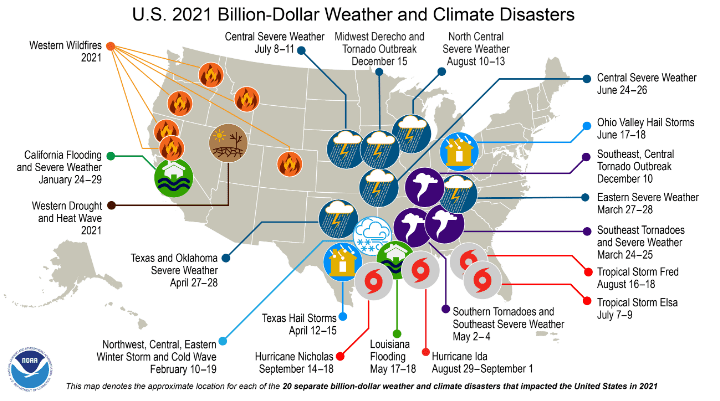Power Companies Must Plan to Deal with Climate Risks

The Intergovernmental Panel on Climate Change (IPCC) issued a report at the end of February titled Climate Change 2022: Impacts, Adaptation and Vulnerability." Among the warnings found in the 3,675-page report is that human-induced climate change is causing dangerous and widespread disruption in nature and affecting the lives of billions of people around the world, despite efforts to reduce the risks.
When we look at the quantitative evidence, we clearly see that global average temperatures and sea levels have risen over the last 150 years, and that we are still on that trend. We also see that climate models cannot replicate historical observed global and continental changes without the human-related inputs, such as greenhouse gas emissions and land use activity," Dr. Steven Rose, senior research economist and technical executive in the Energy Systems and Climate Analysis Group at the Electric Power Research Institute (EPRI), who was also one of the lead authors of the IPCC report, told POWER.
The evidence that climate change is affecting society and ecosystems has grown and is continuing to grow. That evidence not only helps us characterize the risks, but also helps us understand the contributions of both climate and societal factors that are necessary for managing those risks. The health and prosperity of future society depends on both," he said.
Among Rose's biggest takeaways from the IPCC report are that climate change will affect all natural and human systems; more climate change is expected and climate risks will increase; adaptation and resilience planning will be needed; and the economic impacts of climate change will likely increase with the level of global warming.
The High Cost of Extreme WeatherEarlier this year, the National Oceanic and Atmospheric Administration's National Centers for Environmental Information (NCEI), the self-proclaimed scorekeeper" of severe weather and climate events, reported that there were 20 weather/climate disaster events" with losses exceeding $1 billion each that affected the U.S. in 2021. These events included one drought event, two flooding events, 11 severe storm events, four tropical cyclone events, one wildfire event, and one winter storm event. The events had significant economic impacts, with overall costs estimated to be about $145 billion, according to NCEI estimates.
Among the billion-dollar weather and climate disasters was the winter storm and cold wave that struck much of the U.S. Feb. 10-19, 2021. It brought frigid temperatures, snow, and ice from the Plains to southern Texas. It was the coldest event across the continental U.S. in more than 30 years, according to the NCEI, and it caused power outages for nearly 10 million people. The agency reported that 226 people died as a result of the disaster and the total cost was estimated to be $24 billion.
Another notable event was an extreme heat wave that shattered temperature records across many parts of the Pacific Northwest June 27-30, 2021. Temperatures in Portland, Oregon, soared to 116F, breaking the city's previous all-time high of 107F. Further north, in Seattle, Washington, temperatures reached a sizzling 108F, surpassing the previous record of 103F set in 2009. In Lytton, British Columbia, the temperature hit 121F, setting a new national record in Canada. The NCEI lumped that event together with widespread drought conditions across many Western states, and reported a total of 229 deaths and cost of $8.9 billion as a result.
Highest CO2 Emissions EverClimate activists have been calling for people to stop burning fossil fuels for decades. While their pleas have helped slow the growth in emissions, the trend has not turned downward yet. The International Energy Agency (IEA) reported on March 8 that global energy-related CO2 emissions increased by 6% in 2021 to 36.3 billion tonnes, the highest level ever, as the world economy rebounded strongly from the COVID-19 crisis and relied heavily on coal to power that growth.
The rebound in global CO2 emissions above pre-pandemic levels has largely been driven by China, where CO2 emissions increased by 750 million tonnes between 2019 and 2021. The emissions increases in China more than offset the aggregate decline in the rest of the world over the same period. In 2021, China's CO2 emissions accounted for nearly a third of the global total. CO2 emissions in India also rebounded strongly in 2021 driven by growth in coal use for electricity generation. Coal-fired generation reached an all-time high in India, spiking 13% above its 2020 level, according to the IEA.
Managing Climate RisksIt is clear that some amount of additional climate change should be expected. So, what should we do? Plan for the effects of a changing climate," Rose said. That planning process needs to start with defining relationships between potential changing climate variables and current technology, system, and market design specifications," he added.
EPRI researchers have conducted extensive analysis on the impacts extreme weather events can have on the power industry. Among recommendations outlined in a recent EPRI report are: ensuring load and renewable generation profiles are synchronized, use sufficient historical data, and incorporate projected climate trends; modeling correlated generating unit outages; and developing/utilizing resource adequacy metrics that consider the outsized impact extreme weather events may have on the system. Additionally, EPRI and the Enel Foundation launched a virtual workshop series focused on electric sector climate adaptation to strengthen electric grid resiliency.
Is there any reason to be optimistic? Rose seemed to think so. I'm most struck by the proactiveness and level of thinking I'm seeing throughout the world. There is certainly a lot more to do, and opportunities to improve, but I see evidence worldwide of constructive efforts to understand the risks of climate change and to address them," he said.
-Aaron Larson is POWER's executive editor.
The post Power Companies Must Plan to Deal with Climate Risks appeared first on POWER Magazine.